
 Haley Strebler, RN – Trauma Injury Prevention and Outreach Coordinator, SSM Health Saint Louis University Hospital:
Haley Strebler, RN – Trauma Injury Prevention and Outreach Coordinator, SSM Health Saint Louis University Hospital:
Haley works at SSM Health Saint Louis University Hospital, which is an ACS-verified (American College of Surgeons) Level 1 trauma center. This means that the ACS has verified that a facility has the resources listed in Resources for Optimal Care of the Injured Patient, a guide published by the ACS to help surgeons and healthcare organizations provide quality care to injured patients.
“Winter sports and recreational activities are so much fun!” says Haley. “But they can come with a risk of head injury, or what we call a Traumatic Brain Injury (TBI). Any ‘bump’ to your head can cause a type of traumatic brain injury. But never fear! Here are some tips you can practice to stay safe during your winter activities.”
- Make sure you have the right safety equipment for your activity. Helmets vary by sport and should not be used across activities. If you play hockey you should be fitted for a different type of helmet than what you use if you snowboard or ski.
- Avoid sledding, skiing, or snowboarding near high traffic areas. Distracted drivers may not notice if you slide out into the road or may not be able to stop in time.
- Choose clear, open, designated areas for sledding, skiing, or snowboarding to avoid unintentional contact with trees or utility poles.
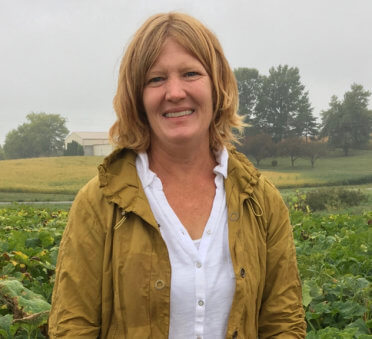 Linda Beckemeier – Manager at Stuckmeyers Farm and Market and Member of the Missouri Farm Bureau:
Linda Beckemeier – Manager at Stuckmeyers Farm and Market and Member of the Missouri Farm Bureau:
Linda is the manager at Stuckmeyers Farm and Market, which keeps her busy year-round with things like vegetable and grain farming, and a Garden Center and Farmer’s Market. Linda and Stuckmeyers are also involved in agritourism activities and events for the public, including a Kid’s Day in the spring and Halloween Fun Farm Days in the fall.
For winter activities, Linda says, “After our busy fall season, we spend many hours finishing up field and harvesting work, cleaning up and packing up the public market and displays.” Despite the winter cold, she says “it’s a good time for keeping up with necessary maintenance and mechanical work.”
“The first week of January we get to work sowing seeds indoors in the greenhouses. We continue working in the greenhouses as shipments of plants arrive in February. These plants are grown, maintained, and transplanted for the upcoming spring season.”
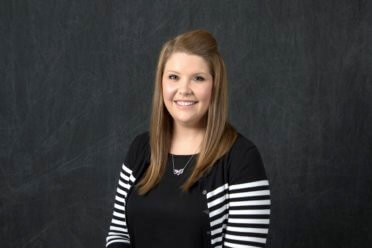 Brooke Magary – Outreach Specialist, U.S. Army Corps of Engineers, St. Louis District:
Brooke Magary – Outreach Specialist, U.S. Army Corps of Engineers, St. Louis District:
Brooke is the Outreach Specialist for the U.S. Army Corps of Engineers, St. Louis District. In addition to having formal training as a biologist, she manages both the Corps’ STEM program for K–12 students and the District’s social media accounts.
One of the winter responsibilities for the Corps involves the operation and maintenance of locks and dams. “Although river traffic does slow down during the winter months,” Brooke says, “barges still move through the locks and dams operated and maintained by the Corps. The St. Louis District is responsible for maintaining a navigation channel nine feet deep and 300 feet wide on 300 miles of the Mississippi River from Saverton, Missouri, to Cairo, Illinois.”
Brooke also has a helpful tip for bird watchers and nature lovers: “In the winter months, bald eagles winter along the Mississippi near the lock and dams, making the river a perfect place for eagle watching!”
 Dr. Katherine Rivera-Spoljaric, MD – Washington University Pediatric Pulmonologist, St. Louis Children’s Hospital:
Dr. Katherine Rivera-Spoljaric, MD – Washington University Pediatric Pulmonologist, St. Louis Children’s Hospital:
Dr. Rivera-Spoljaric works at St. Louis Children’s Hospital as a Pediatric Pulmonologist, a pediatrician that specializes in lung diseases.
Dr. Rivera-Spoljaric shares this winter medical fact: “Some people have more trouble with their asthma during the winter months because the cold, dry air can cause airway muscles to spasm, triggering symptoms like cough, shortness of breath, and wheezing.”
Here are some of her wintertime tips for staying healthy:
- Get your flu vaccine.
- Practice good hand hygiene: Wash your hands for 20 seconds or use hand sanitizers frequently (especially before meals), and try to keep your hands away from your face.
- Keep warm with protective clothing and warm up before going outside.
- Wear a scarf loosely around your mouth to warm the air that is going into your lungs.
- Drink enough fluids.
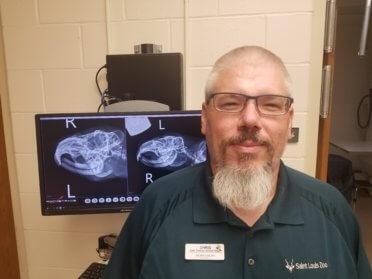 Christopher S. Hanley, DVM, Dipl ACZM – Asst. Director of Animal Health, Saint Louis Zoo:
Christopher S. Hanley, DVM, Dipl ACZM – Asst. Director of Animal Health, Saint Louis Zoo:
Chris serves as the Assistant Director of Animal Health at the Saint Louis Zoo. Before an animal leaves the Zoo or joins their animal community, Chris and his team do a thorough examination and testing to make sure the animal’s healthy.
“While there are fewer moves during the colder months,” Chris says, “there are still some animals that come and go year-round and we provide the health checks to make that happen.” According to Chris, “Animals also don’t consider the weather when they are not feeling well, so we are always ready to respond to sick animals and emergencies year-round. There are, however, some animal care procedures specifically performed during the winter months.”
- Annual exams of our three-generation, nine-member Asian elephant family happen in winter.
- All marine mammals (seals, sea lions and polar bears) are required to have a visual examination every six months, so one of those sessions occurs in the winter.
- Winter is a good time to assess protocols and look at our preventive medicine calendar, identifying upcoming procedures and exams that will take more coordination and possibly involve outside consultants.
- Procedures to remove or replace birth control implants in certain species usually takes place in winter.
- In partnership with our Research Department, we participate in semen collection and artificial inseminations in Mexican wolves at the Endangered Wolf Center—these happen in January and February because that is the breeding season of this species.
 Kevin Daugherty – Director, Illinois Center for Agricultural Engagement, and member of the Illinois Farm Bureau:
Kevin Daugherty – Director, Illinois Center for Agricultural Engagement, and member of the Illinois Farm Bureau:
Kevin is the Director for the Illinois Center for Agricultural Engagement. “As harvest is completed, the days grow shorter, and the winds blow colder air across the state,” he says, “farmers continue to remain active with various STEM-related activities.”
Kevin says, “Proper soil drainage is important for farmers, and winter is prime time to determine if [drainage] tile needs to be replaced, and how it will be replaced.” Farmers can also make good use of winter to perform maintenance or make repairs on farm equipment. “This means taking care of equipment used during harvest as well as preparing equipment that is used for upcoming spring planting.”
Finally, Kevin also describes winter as a time for paperwork. “Catching up on all activities from a busy fall,” he says. This includes things like data and research, banking, and financial activities.
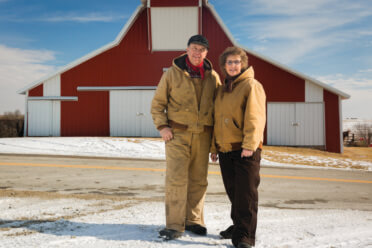 Rick Ayers – Cattle Farmer, Ayers Cattle Farm, and member of Missouri Beef Industry Council:
Rick Ayers – Cattle Farmer, Ayers Cattle Farm, and member of Missouri Beef Industry Council:
Rick and his wife, Jonna, are cattle farmers at Ayers Cattle Farm in Green City, Missouri. “Animal care is top of mind every day of the year,” Rick says, “and especially in hot and cold seasons.” Rick and his wife both bring a background in high school agriculture education to their farm as well.
In addition to ensuring his animals have water to drink in the wintertime, Rick also spends time each day feeding his herd a mix of corn and soybean meal for a supplemental source of protein. Rick also makes sure his herd has access to mineral supplements for consumption as needed.
Other parts of Rick’s day-to-day work on the farm include fixing fences whenever and wherever needed, as well as monitoring the herd through detailed quality measurements and record-keeping.
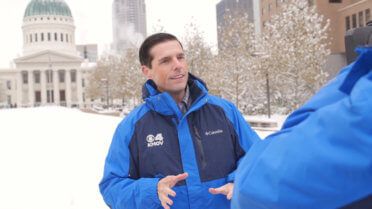 Steve Templeton – Chief Meteorologist, KMOV TV:
Steve Templeton – Chief Meteorologist, KMOV TV:
As Chief Meteorologist at KMOV TV, Steve says, “My job is about keeping people in the local community informed about the weather because I realize the impact it could have on their lives.”
“I study forecast models and information to create weather forecasts and graphics,” he says, “which I then present as part of a news broadcast at 4:00, 5:00, 6:00, and 10:00 p.m., Monday through Friday.” He also communicates forecasts and weather information to the public using social media platforms.
Winter forecasting takes a different set of skills, according to Steve. For example:
- I use terminology that is unique to the winter months, talking about freezing rain, sleet, and wet vs. dry snow.
- I have to focus on things such as wind, snow, ice, and not only air temperature, but also ground temperature. Those are critical factors here in St. Louis because they have a greater impact on people in the winter.
- It’s more difficult to forecast winter weather, and there is a greater pressure to not only be accurate, but also to communicate the uncertainties in a forecast clearly because an extra inch of snow that might fall, and whether it will melt or stick, can make a bigger difference than an extra inch of rain at other times of the year. We understand the enormous potential impact in people’s lives, and we want them to be able to prepare well for those weather impacts.
Steve also shares these fun facts:
- For my job, I don’t spend too much time outside. I spend a lot of time working in front of a computer in a windowless studio.
- Dry snow occurs in really cold temperatures (in the teens on a Fahrenheit scale), is fluffy and light and doesn’t stick. Wet snow occurs in temperatures close to or just below freezing. It sticks and makes great snowballs and snowmen, but is also harder to shovel, and can even be a health risk to some because of its weight.





